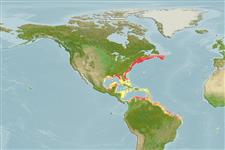Common names from other countries
Environment: milieu / climate zone / depth range / distribution range
Ecologia
marino demersale; oceanodromo (Ref. 51243); distribuzione batimetrica 1 - 477 m (Ref. 5951), usually 75 - 150 m (Ref. 5951). Subtropical; 46°N - 16°S, 97°W - 5°W
Western Atlantic: Cape Cod in Massachusetts to northeastern Florida in USA and northern Gulf of Mexico. Reported in eastern Atlantic: St. Helena (Ref. 5288). Northwest Atlantic: Canada (Ref. 5951).
Size / Peso / Age
Maturity: Lm ? range ? - ? cm
Max length : 230 cm TL maschio/sesso non determinato; (Ref. 7251); common length : 100.0 cm TL maschio/sesso non determinato; (Ref. 3715); peso massimo pubblicato: 40.0 kg (Ref. 7251)
Occurs from shallow inshore waters to depths of 477 m and up to 260 m in the Gulf of Maine (Ref. 7135). Benthic (Ref. 5951). Nocturnal predators (Ref. 93252). Feeds mainly on fishes, but also on shrimps and small shellfish. Commonly caught by anglers along piers, docks and jetties in middle Atlantic states.
Life cycle and mating behavior
Maturities | Riproduzione | Spawnings | Egg(s) | Fecundities | Larve
Robins, C.R. and G.C. Ray, 1986. A field guide to Atlantic coast fishes of North America. Houghton Mifflin Company, Boston, U.S.A. 354 p. (Ref. 7251)
IUCN Red List Status (Ref. 130435)
CITES (Ref. 128078)
Not Evaluated
Threat to humans
Harmless
Human uses
Pesca: scarso interesse commerciale
Strumenti
Special reports
Download XML
Fonti Internet
Estimates based on models
Preferred temperature (Ref.
115969): 7.1 - 25.2, mean 19.7 (based on 61 cells).
Phylogenetic diversity index (Ref.
82804): PD
50 = 0.5000 [Uniqueness, from 0.5 = low to 2.0 = high].
Bayesian length-weight: a=0.00049 (0.00027 - 0.00088), b=3.25 (3.09 - 3.41), in cm Total Length, based on LWR estimates for this species & Genus-body shape (Ref.
93245).
Trophic level (Ref.
69278): 4.5 ±0.8 se; based on diet studies.
Resilienza (Ref.
120179): Basso, tempo minimo di raddoppiamento della popolazione 4.5 - 14 anni (Assuming tm>4).
Fishing Vulnerability (Ref.
59153): Very high vulnerability (90 of 100).
Climate Vulnerability (Ref.
125649): High vulnerability (60 of 100).
